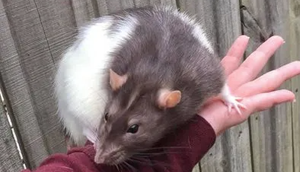Chocolate and Chocolate Agouti


- Abby Chronister
- Published 2/21/2021
- Genetics
- Photo courtesy of Laughin' Place Rattery
Chocolate was first bred in 1915 and was standardized in 1935 in the UK. In 1976, it was taken over by the NFRS but removed from standards in 1978. In 1981, Chriss Lown reintroduced the color and in 1983 it was again accepted in the NFRS standards. Chocolate was first scientifically described in 1932. Chocolate agouti is the agouti variant.
Genetics
Chocolate (or the agouti variant known as Chocolate Agouti) is caused by the recessive allele on the “b” locus or “brown” locus. The alleles found on this locus determine whether or not the eumelanin pigment in the hair shafts will be black (B) or brown (b). When an animal is BB or Bb, the eumelanin will be black, but if the animal is bb (has 2 copies of the recessive allele present), the eumelanin will be brown. Chocolate is a single-recessive color, so it’s created only by the b locus and not a combination of recessives.
It is a common issue that poor blacks resemble extremely dark chocolates and are often mistaken as such.
AFRMA Standard: A deep rich chocolate, as even as possible, devoid of dinginess and white hairs or patches. The feet to match top color. Eyes black. (English, N.F.R.S.)
NFRS Standard: To be a deep, rich chocolate, as even as possible, devoid of any dinginess and white hairs or patches. Foot colour to match top. Eyes black.
United Rat Community Standard: TBD – Chocolate Agouti known as Gingerbread
YOU MAY LIKE

The incomplete dominance shown by b in one strain could be a unique occurrence.
Color Variation
It has been suggested that a Bb Agouti animal may visually present as more “brown” than a BB counterpart. If true, this suggests a partial dominance or at least a strong penetrance. However, this may be strain dependent and one strain may have stronger penetrance than another.
It has also been stated that, like the brown allele in mice, the brown allele in rats may promote larger body sizes. This hasn’t been studied extensively, but a small pattern was seen in a few 4-month-old Cinnamon rats being just slightly larger than their non-chocolate counterparts.
CItations
Robinson, R. (1965). Color Variation: Brown. In Genetics of the norway rat (pp. 14–14). essay.

